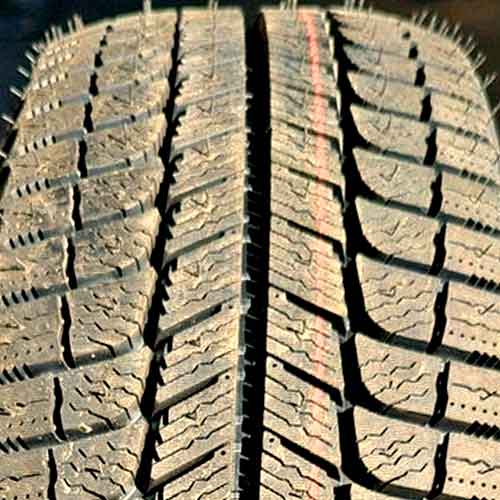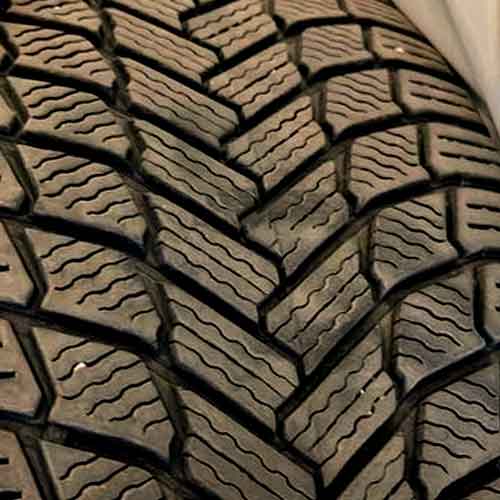Both the Michelin X Ice Snow and the XI3 stand as benchmarks in the winter tire segment, each offering unique performance attributes, fuel efficiency, and ride comfort, thereby offering a broad spectrum of options for various user needs and road conditions.

Table of Contents
Available Sizes
The Michelin X-Ice Snow comes in 125 total sizes in 15 to 22 inches. They have following specs.
- Speed ratings: T and H.
- Load ratings: SL and XL.
- Tread depth: 10.5/32″ on all.
- Weight: 16 to 40 lbs.
- Tread warranty: 40k miles.
Review X-Ice Snow in greater details: https://snowytires.com/michelin-x-ice-snow-review/
On the other side, the Michelin X Ice XI3 (used to) come in 14 to 19 inches rims with following specs.
- Speed ratings: T and H.
- Load ratings: SL or XL.
- Tread depth: 10.5/32″.
- Weight: 16 to 30 lbs.
- Tread warranty: 40k miles.
Tread Pattern
Starting with the Michelin X Ice XI3, the tire sports a highly distinctive pattern.

Starting from its center, you’ll notice a straight longitudinal groove in the core area, underscored by minute ridges at the base.
These are engineered to grip snow particles, offering impressive traction capabilities.
The adjacent blocks resting on two ribs, creating two additional longitudinal channels, though they are zigzag, and not as straight as the one in the middle.
Lugs here have chamfered sides, off-set edges, and of course wave-like siping.
The shoulder lugs display an elongated form, yielding a more curvilinear design.
Moreover, these blocks are adorned with multi-angled sipes and wave-like, longitudinal notches within the grooves.
On the other side, the Michelin X-Ice Snow also possesses a one-of-a-kind, directional tread design.

The tread is made out of 6 total ribs, which together form a total of 5 circumferential channels.
The toughest-passing (longitudinal) groove, located in the middle most area, is the most slender, and is constituted of two ribs carrying blocks seen with sharp-edges and wave like siping.
These design features are also seen on the surrounding lugs.
Though these blocks only have wave like siping and missing with rectilinear ones.
But still overall, the most aggressive siping pattern is seen on the shoulder blocks.
Though they also carry similar tread features like seen everywhere else.
Directional Gripping
Directional or longitudinal grip, a vital component of tire’s overall dry performance, primarily depends on the design of the tread’s central tread area.
This is because this middle area of the tread bears the majority of weight, during straight-line driving.
And so considering both tires, in this aspect, it’s no surprise that the Michelin X-Ice Snow outperforms its counterpart by a landslide.
Simply put, the tire features more rubber to road contact from its middle, with its interlocking lugs there.
Instead, the Michelin XI3 offers a large longitudinal groove there. So on tests, it shows up with 5 feet longer braking distance values.
Lateral Gripping
Dry handling performance is majorly determined by the design of shoulder lugs, and the overall tire flexibility.
And within this context, the Michelin X-Ice Snow, again, significantly outperforms its predecessor.
The Michelin X-Ice Snow incorporates numerous biting edges on its shoulder lugs and narrower lateral grooves, which work together to enhance grip.
Meanwhile, the thicker lugs with fewer biting edges on the Michelin X Ice XI3 limit its grip capacity.
Moreover, the heavier weight of the Michelin X Ice XI3 during cornering can increase lug flexing, leading to delayed oversteer and understeer responses, reducing the tire’s overall responsiveness to steering inputs.
In contrast, the lighter weight and more flexible design of the Michelin X-Ice Snow manage these cornering forces effectively, thereby delivering superior handling performance, particularly when navigating turns.
Tread Life
Tread longevity is heavily influenced by rolling resistance, a factor determined by weight and tread design. Simply put, the lighter the tire, the better its tread life. This is because a lighter tire generates less pressure on the road surface, reducing friction and slowing the rate of wear.
Consequently, the Michelin X-Ice Snow, thanks to its lighter frame, has the upper hand in tread life. Its lugs create less friction and heat due to less ground pressure, leading to greater wear resistance.
In contrast, the Michelin X Ice XI3 falls short due to its greater weight, less streamlined lugs, and outdated rubber composition, placing it behind its newer counterpart, the X Ice Snow.
Noise Generation
Tire noise is largely a result of air particles colliding against the tread walls, and its volume can greatly influence the overall driving experience. Therefore, effective noise management is key in tire design.
In this regard, the Michelin X-Ice Snow takes the lead over the Michelin X Ice XI3, thanks to a tread pattern with fewer voids.
Fewer voids mean fewer air cavities for noise propagation, resulting in less noise as the tire rolls.
This design element makes the Michelin X-Ice Snow a quieter performer, boosting comfort levels for both driver and passengers.
Wet Traction
A tire’s capacity to perform on wet surfaces hinges on its tread design and rubber composition. And in this aspect, the Michelin X-Ice Snow surpasses its rivals in numerous factors including grip, handling, and resistance to hydroplaning.
The Michelin X-Ice Snow’s advanced rubber compound offers superior water dispersal abilities, significantly enhancing traction on damp surfaces.
Coupled with its multi-angled sipe design, this tire enables swift water evacuation from the contact patch, resulting in superior grip, particularly on wet roads.
Moreover, the superior interconnected tread voids or grooves provide exceptional water channeling capabilities in all directions, resulting in heightened resistance to hydroplaning.
This robust design ensures greater vehicle control even at higher speeds during both straight-line and curved aquaplaning situations.
Fuel Economy
Fuel efficiency in tires primarily depends on the tire’s interaction with the road surface and its overall weight. Both of these factors impact the tire’s rolling resistance, which significantly affects the vehicle’s energy usage.
In this regard, the Michelin X-Ice Snow stands out due to its lighter weight and design featuring longitudinally aligned ribs, providing better aerodynamic efficiency compared to the larger-spaced pattern of the Michelin X Ice XI3.
This results in smoother, more energy-efficient travel, particularly during straight-line movement like highway driving.
Therefore, when it comes to fuel economy, the X-Ice Snow outshines its competition.
Vibration Absorption
Tires serve as the first line of defense against road irregularities, acting as secondary suspension systems for vehicles.
In this context, the Michelin X-Ice Snow, with its next-generation compound, excels in shock absorption.
When encountering uneven surfaces, the construction of the Michelin X-Ice Snow adeptly absorbs these disturbances, delivering a smoother ride.
Furthermore, its lighter weight improves steering feedback, offering a more refined ride experience compared to the Michelin X Ice XI3.
Ice Performance
When traversing icy surfaces, the Michelin X-Ice Snow remarkably outshines its predecessor, showcasing a shorter braking distance by an average of 11 feet.
This stellar performance can be attributed to its next-generation tread compound combined with meticulously designed biters distributed across the tire.
The Michelin X-Ice Snow boasts an innovative biter design, characterized by streamlined, slanted incisions seamlessly integrated with snow vices arranged in both lateral directions.
This cutting-edge design significantly amplifies ice grip. In addition, the tire’s more aggressive siping pattern provides superior adhesion on icy surfaces.
In contrast, while the Michelin X Ice XI3 performs admirably on fluffier snow, it falls short on icy terrains compared to its newer counterpart.
Fluffy Snow Performance
Handling fluffy snow requires a distinct approach compared to ice management, and in this category, the Michelin X Ice XI3 pulls ahead with its slightly more open tread design.
This design feature encompasses specially designed biters that can effectively trap soft snow particles within the tire’s tread.
The result is more efficient snow-to-snow contact, which enhances traction as snow binds more effectively to itself than to rubber.
On the other hand, the Michelin X-Ice Snow adopts a more minimalist approach towards handling snow.
Its compact tread design, marked by aggressive small biters, doesn’t retain as much snow, leading to a slightly diminished performance in fluffy snow conditions.
So What’s the Verdict?
When comparing the two Michelin X Ice models, the X-Ice Snow overwhelmingly triumphs in several areas. It offers superior dry traction and handling due to a more streamlined central rib and an array of biting edges on its shoulder lugs.
Furthermore, the tire’s lighter frame translates into better fuel efficiency and tread longevity. The reduced tread voids result in a quieter ride, and the intricate biter design offers superior traction on both wet and icy surfaces.
However, when it comes to performance on fluffy snow, the Michelin X Ice XI3 still holds a slight advantage.